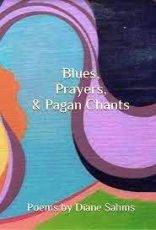Feb 19 2024
London Grip Poetry Review – Diane Sahms
Poetry review – BLUES, PRAYERS, & PAGAN CHANTS: Charles Rammelkamp is especially appreciative of the gratitude present in these poems by Diane Sahms
Blues, Prayers & Pagan Chants Diane Sahms Alien Buddha Press, 2024 ISBN: 979-8873734580 86 pages $11.25
Itself like a line of poetry, the title of Diane Sahms’ lyrical new collection of poems is also an agenda for what comes next. Epigraphs from Leon Russell (Blues), Andy Warhol (Prayers) and Lord Byron (Pagan Chants) introduce the collection, but it begins, almost biblically, with a series of Songs of Praise. These are six poems in gratitude for birds – Rose-breasted Grosbeak, Goldfinch, Downy Woodpecker (‘During winter’s quiet sermon / of undressed trees, / he arrives like a prophet / with red flamed yarmulke’), Oriole, Catbird, and Mourning Dove. To the Catbird she expresses gratitude for his song, like a an expression of grief for a dead friend. This, indeed, is the essence of prayer. To my thinking, gratitude is the most religious posture a human being can achieve.
Then my humbled eyes weep in gratitude, your lamentation more beautiful than mine.
Gratitude for the natural world abounds throughout the collection – Monarch butterflies, swallowtails, wildflowers – another six-poem suite in a variety of Japanese forms (haiku, tanka, etc.) that focus on coneflowers, hydrangeas, milkweed, black-eyed Susans, forget-me-nots, wild roses and Jacob’s ladder. Sahms writes in praise of Dogwood trees, irises, Song Sparrows, an aging spider, the sky above us, and even the lowly slug. The natural world is something to cherish, not take for granted.
In the poem, “I dreamt you, swallowtail,” while closely observing the butterfly’s characteristics and movements, Sahms is also lamenting the death of a dearly loved aunt. And so we enter another potent theme, the blues. She writes:
The summer after you died, egg of my thoughts quietly hatched
into many dazed pages of your daily absence.
After one hellish, sleepless night swallowtail reappears
in mourning air, delightful on Buddleia’s
delicate, intricate weave of purple florets.
It quivers gently from one lobe to the other
like a lost lover’s whispers.
The elegy closes on a note of sorrow. ‘I am St. Francis’s statue, the kind that can miraculously cry.’ Elegies are almost by definition saturated with the blues.
“Tyger Swallowtails,” after William Blake, is another poem in which Sahms closely observes the butterfly, its ‘untamed gold flamed wings, / pattern welded black stripes, / everywhere a hammering eye.’ Indeed, the poem, while unabashedly exulting in nature and natural beauty, explicitly echoes Blake: ‘he who made the lamb made thee.’ The poem is immediately followed by another poem involving swallowtails, “Ambush Blues” (‘Black swallowtail gently flutters…’), and we are back to the blues.
The blues, melancholy, musical, occur throughout the collection, in such titles as “Lady Blue,” “Dem Dare Blues,” “My Lover’s Blues,” “Way beyond the blue,” “Blue Shoes,” “Operatic Blues,” “Burning Blue,” “Morning Glory Blues,” “Ambush Blues,” “Divorce Blues,” “Blue Moon,” “Doggone Blues,” and “Cricket Blues.”
“Dem Dare Blues,” in tribute to the poet’s father, is written in an old-time Philadelphia patois. Sahms is a native and a resident of Philadelphia, where she is the poetry editor for North of Oxford. The poem begins:
Blues, blues, blues
dem dare blues
I reckon I’m fixin’ on blues.
I walk endless blues for weeks
on end. Can’t pick my face up
off the sidewalk.
Sahms’ poem “Depression” gets right at the core of the blues. ‘Most of living is pretending to be happy,’ she writes, ‘when the fact is: you die a little every day, until the last day.’ That’s about as stark as you can get!
Pagan chants? It’s no accident that Diane Sahms includes a poem in homage to Lady Chatterley, D.H. Lawrence’s earthy heroine. Lawrence, like Yeats and Robert Graves, has been described as a “Neo pagan,” pantheistic, animistic. In “Lady Chatterley,” Sahms writes:
She left, to come home to the garden of self,
greets naked body with orgasmic garland.
Camellia japonicas’ blossoms as a lei
softly brush against pink saucers of areolae.
Lilacs woven into her own floral crown
wreaths waist length hair.
A pagan goddess if there ever was one! Sahms channels this vibe elsewhere, as in her love poem to her partner, “Urban Garden, a love poem.” The poem begins:
In marbleized moonlight hidden
garden, as if part of Eden
had secretly fallen. Discreet
in city’s concreteness, just
at the bend of a shared neighborly
driveway, where waist high
red & pink roses tell
of passionate love.
The final poem in the collection, “Cricket Blues,” sums up all of these attitudes, gathers all of the themes, from the pagan exaltation of nature and the earthy expression of passion to the very melancholic blues at the heart of it all. Likening the cricket’s song to the great bluesman Muddy Waters, Sahms describes the insect’s sound as:
a calling song into night’s open mic:
I Just Want to Make Love to You,
Love to You.
Like all the best poetry, Blues, Prayers & Pagan Chants makes you reconsider your ethical and aesthetic assumptions about life and the world and offers a different, deeper perspective.

First Review of Blues, Prayers, & Pagan Chants | Diane Sahms
20/02/2024 @ 00:19
[…] London Grip Poetry Review – Diane Sahms […]